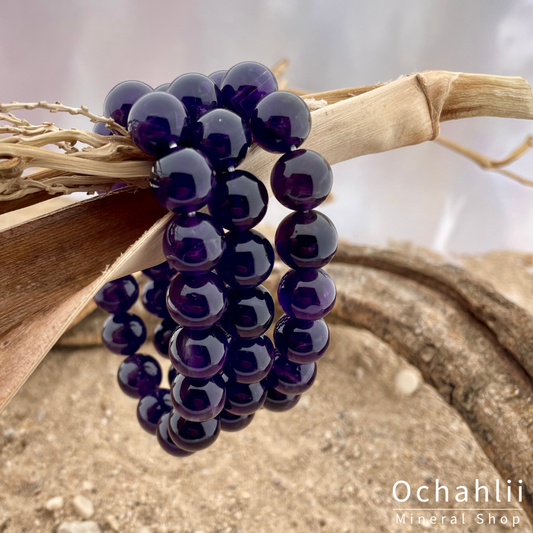
Amethyst - A Deep Dive into the World of This Enchanting Gemstone
Share
Discover the world of amethyst, one of the most beloved and fascinating gemstones. With its rich purple color and intriguing history, this stone has captured the hearts of many. In this blog we take you on a journey through the magic, history and unique properties of amethyst.
The Historical Enchantment of Amethyst: Amethyst is not only known for its beauty, but also for its historical significance. This beautiful stone was already prized by ancient civilizations such as the Egyptians, Etruscans and Romans. In the Middle Ages, the amethyst was highly sought after in Europe and was known as the 'bishop's stone', often worn by church dignitaries. The Smithsonian Institution in Washington DC owns a cut amethyst from Brazil of 1,362 carats and one from North Carolina of 202.5 carats. Amethysts were often used in state jewelry, such as the scepter of Catherine the Great and the scepter of the British Crown.

An intriguing aspect of amethyst is the origin of its name, which takes us back to the ancient Greeks. The name 'amethyst' is derived from the Ancient Greek word 'amethystos', which literally means 'non-intoxicating'. This stems from the ancient Greek belief that the stone would protect the wearer from the effects of drunkenness. There was a widespread belief that drinking from a cup made of amethyst or wearing the stone would prevent one from becoming drunk. This fascinating historical association with temperance and clarity of mind has contributed to amethyst's enduring allure over the centuries.

The Mystical Properties of Amethyst: Amethyst symbolizes spiritual growth and awareness, often used to deepen meditation and reach a higher level of consciousness. It is associated with protection, known for its ability to clear negative energy and transform it into positive vibrations. This stone is closely associated with the Third Eye and Crown Chakras, enhancing intuition and psychic abilities, and aiding in gaining spiritual insights. Amethyst provides emotional support by relieving stress, anxiety and sadness, and is also used to overcome addictions. In addition, it is considered an aid for promoting restful sleep and reducing nightmares, making it a stone that promotes both physical and emotional balance and well-being. Placing amethyst on your desk can help improve memory and increase concentration.
Occurrence and Formation: Geologically, amethyst forms primarily in cavities of igneous rock known as geodes. Europe, Brazil, Mexico and Uruguay are some of the most important sites. The stone can fade in sunlight due to the UV light present, so caution is advised when exposed.
Diversity in Shape and Origin: Amethyst gemstone is characterized by its hexagonal crystal shape and occurs in various growth forms such as clusters and rosettes. Special varieties such as Vera Cruz and Chevron amethyst are distinguished by unique shapes and shades.

Chemical Composition and Technical Details: For geology and mineralogy enthusiasts, amethyst is a variety of quartz (SiO2) with a trigonal crystal structure. It contains trace elements of iron and titanium, which contribute to its characteristic purple color. When heated, amethyst changes color, resulting in prasiolite or, incorrectly sold as, citrine.
Here are some technical specifications of amethyst:
- Chemical Formula: SiO2(Ti4+, Fe3+)
- Hardness: 7 on the Mohs scale
- Crystal system: Trigonal
- Occurrence: Worldwide, with major producers such as Brazil and Uruguay
Conclusion: Amethyst remains one of the most enchanting and versatile gemstones in the world. Whether worn as a beautiful piece of jewelry or used for its spiritual and healing properties, the fascination with amethyst has persisted through the ages. This beautiful purple stone, with its rich history and deep spiritual meaning, remains a timeless treasure in the world of gemstones.
sources: minedat and wikipedia




